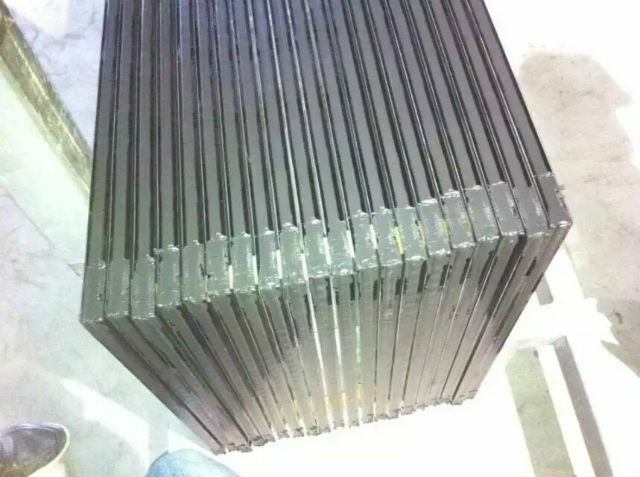
中空玻璃注膠流程時常出現的問題
時間:2024-02-28 來源:http://www.aabrs.cn/ 發布人:昌盛機械
市場上的中空玻璃大多數采用的是雙道密封工藝,通常第一道密封采用的是丁基膠,其主要作用是固定鋁條,降低水汽及氣體在邊緣的滲透性。二道密封膠有硅酮密封膠、聚硫密封膠、聚氨酯密封膠幾種,分結構性裝配和非結構性裝配,在中空玻璃中的作用首先是密封,即保持空氣層內的氣體,促進中空玻璃的性能保持;其次是粘結,即把各元件牢固的連接在一起,保持中空玻璃的結構穩定。
Most of the insulating glass on the market adopts a dual sealing process, usually using butyl rubber as the first sealing, which is mainly used to fix the aluminum strip and reduce the permeability of water vapor and gas at the edges. There are several types of sealant, including silicone sealant, polysulfide sealant, and polyurethane sealant, which are divided into structural assembly and non structural assembly. The first function in insulating glass is to seal, that is, to maintain the gas in the air layer and promote the performance of the insulating glass; Next is bonding, which firmly connects the components together to maintain the structural stability of the insulating glass.
中空玻璃密封膠是決定中空玻璃性能優劣的主要因素,但要得到優質可靠地中空玻璃僅僅選擇質量性能優異的密封膠是不夠的,另一個重要的環節是實際生產中的注膠工藝,決定著中空玻璃制品的綜合質量。中空玻璃用雙道密封膠都有嚴格的施工方法和要求,具體如下:
Hollow glass sealant is the main factor determining the performance of hollow glass, but to obtain high-quality and reliable hollow glass, it is not enough to only choose sealant with excellent quality and performance. Another important link is the injection process in actual production, which determines the comprehensive quality of hollow glass products. There are strict construction methods and requirements for double-layer sealant used in insulating glass, as follows:
一、第一道密封:熱熔丁基膠
1、 First sealing: hot melt butyl adhesive
丁基密封膠是槽鋁式雙道中空玻璃的第一道密封,它是一種熱熔膠,具有很低的水氣透過率(在中空玻璃密封膠中低)和很高的粘性,是鋁條側面和玻璃之間阻隔水汽的有效屏障;實現間隔框與玻璃的定位組裝,為二道密封膠的涂施、固化和中空玻璃的成型提供基礎。
Butyl sealant is the first seal of slot aluminum double channel insulating glass. It is a hot melt adhesive with low water vapor permeability (low in insulating glass sealant) and high viscosity. It is an effective barrier between the side of the aluminum strip and the glass to block water vapor; Realize the positioning and assembly of the spacing frame and glass, providing a foundation for the application and curing of the second layer of sealant and the formation of the hollow glass.
第一道密封膠的注膠工藝
The injection process of the first sealant
1、進場檢驗:打開包裝,檢查有無明顯顆粒和雜物
1. Entry inspection: Open the packaging and check for obvious particles and debris
2、清洗基材
2. Cleaning the substrate
3、根據不同的施工環境調整丁基膠的擠出溫度,根據涂膠速度、出膠量大小調整丁基膠的擠出壓力
3. Adjust the extrusion temperature of butyl rubber according to different construction environments, and adjust the extrusion pressure of butyl rubber according to the coating speed and the amount of adhesive produced
4、涂膠。涂膠前先排盡丁基膠涂布機氣缸內的空氣,涂膠過程中仔細檢查鋁隔條上涂布的丁基膠有無斷線、氣泡及雜質,是否涂布均勻,必要時應重新涂敷或補膠。
4. Apply glue. Before applying adhesive, exhaust the air inside the cylinder of the butyl adhesive coating machine. During the adhesive application process, carefully check whether the butyl adhesive applied on the aluminum spacer strip has broken lines, bubbles, and impurities, and whether it is evenly applied. If necessary, reapply or supplement the adhesive.
5、合片
5. Composite film
6、進入二道密封。
6. Enter the second seal.
二、第二道密封:雙組份硅酮密封膠或聚硫、聚氨酯密封膠
2、 Second sealing: Two component silicone sealant or polysulfide/polyurethane sealant
二道密封膠不僅要將玻璃和間隔框粘結成一個整體,而且可以起彈性恢復并緩沖邊部應力等輔助性作用。要提高中空玻璃的性能和密封壽命,密封膠必須具有良好的粘結性、優良的結構強度和彈性、優異的耐候性。
The second layer of sealant not only needs to bond the glass and spacing frame into a whole, but also has auxiliary effects such as elastic recovery and buffering of edge stress. To improve the performance and sealing life of insulating glass, sealant must have good adhesion, excellent structural strength and elasticity, and excellent weather resistance.
第二道密封膠的注膠工藝(以雙組份硅酮密封膠為例)
The injection process of the second sealant (using two-component silicone sealant as an example)
1、進場檢驗:蝴蝶測試,檢查硅酮密封膠的混合均勻性;拉斷時間測試,拉斷時間和AB組分的混合比例有關,同時可提供膠的工作時間及膠內部深度固化的時間參考;剝離粘結性實驗,檢驗膠對實際基材的粘結性。
1. Entry inspection: Butterfly test to check the mixing uniformity of silicone sealant; The break time test is related to the mixing ratio of AB components, and can also provide reference for the working time of the adhesive and the time for deep curing inside the adhesive; Peel off adhesion experiment to test the adhesion of the adhesive to the actual substrate.
2、基材清洗
2. Substrate cleaning
3、嚴格按照生產廠商提供的比例混合A/B組分,混合充分,若為手工操作,一次混膠不要太多,以免提前固化影響粘結強度。
3. Strictly mix the A/B components according to the proportion provided by the manufacturer, and mix thoroughly. If it is manual operation, do not mix too much at once to avoid early curing and affecting the bonding strength.
4、注膠。可使用雙組份打膠機或人工涂膠。使用打膠機時,打膠機應當裝有A/B組分供膠壓力指示表,出膠壓力連續可調,均勻注入到玻璃封膠區,完全填實間隔條框兩側,注膠過程中,應當隨時觀察第二道密封膠的注膠量,保證密封膠充分與丁基膠接觸并與玻璃邊平齊,中間不得有氣道、氣泡,膠深應符合要求。
4. Glue injection. Two component gluing machine or manual gluing can be used. When using the glue machine, it should be equipped with a pressure indicator for A/B component glue supply. The glue output pressure should be continuously adjustable and evenly injected into the glass sealing area, completely filling both sides of the spacer frame. During the glue injection process, the amount of the second sealant should be observed at all times to ensure that the sealant is fully in contact with the butyl adhesive and flush with the glass edge. There should be no air ducts or bubbles in the middle, and the glue depth should meet the requirements.
5、靜置與養護。注完膠的玻璃構件及時移至靜置場所進行養護,要求溫度10-35攝氏度,相對濕度為35%~75%,無油污,無大量灰塵,玻璃構件靜置三到五天后方可挪動及運輸,且應當待總養護期到14天后方可進行安裝施工。
5. Staying still and maintenance. The glass components that have been glued should be moved to a static place for maintenance in a timely manner, with a temperature of 10-35 degrees Celsius, a relative humidity of 35%~75%, no oil stains, and no large amount of dust. The glass components can only be moved and transported after three to five days of standing, and installation and construction should be carried out after the total maintenance period reaches 14 days.
三、中空玻璃密封膠在使用過程中出現的典型問題及解決方案
3、 Typical problems and solutions of insulating glass sealant during use
密封膠施工是個復雜的過程,涉及許多因素:基材性能、施工時的天氣、工作環境、施工設備、施工人員等的,因此經常出現各種施工問題,下面就生產中的一些典型案例做具體分析。

Sealant construction is a complex process that involves many factors such as substrate performance, weather conditions during construction, working environment, construction equipment, construction personnel, etc. Therefore, various construction problems often occur. Below are some typical cases in production for specific analysis.
(1)玻璃部分粘結不理想
(1) Poor bonding of glass parts
1、事先是否按規范做相容性測試
1. Have compatibility tests been conducted in advance according to the specifications
2、養護時間短就進行剝離性粘結測試,養護溫度較低(尤其在冬天)
2. If the curing time is short, conduct peel adhesion testing, and the curing temperature is low (especially in winter)
3、泵的氣壓不足,導致膠混合不勻,粘結效果要差些,同時容易造成槍頭壓力不足,打的膠縫不致密(密實度不夠)
3. The insufficient air pressure of the pump leads to uneven mixing of the adhesive, resulting in poor bonding effect. At the same time, it is easy to cause insufficient pressure on the gun head, resulting in less dense adhesive joints (insufficient density)
4、設備故障問題,導致膠混合效果不佳。如果打膠機的氣缸密封墊磨損的時候,就會導致不一致的固化劑混合入膠內,AB泵工作行程不同步或者不匹配,AB組分混合不均勻,出現花膠情況。有些在剛打完膠時還檢查不出來,等膠干透了,就會透過玻璃看到花膠。可采用連續擠出測試來判斷一下,即在一張平板上來回打出一條蛇形的密封膠,時間維持在三到五分鐘,讓泵至少運轉2個周期,檢查是否存在異常情況(即所謂的軟點)。
4. Equipment malfunction caused poor adhesive mixing effect. If the sealing gasket of the cylinder of the glue machine wears out, it will cause inconsistent curing agents to mix into the glue, the working stroke of the AB pump is not synchronized or matched, and the AB components are mixed unevenly, resulting in adhesive problems. Some of them cannot be detected even after the glue is applied, and when the glue is completely dry, the flower glue will be seen through the glass. Continuous extrusion testing can be used to determine whether there are any abnormal conditions (so-called soft spots) by repeatedly applying a snake shaped sealant on a flat plate for three to five minutes and allowing the pump to run for at least two cycles.
5、不同廠家的AB膠混用
5. Mixing AB adhesive from different manufacturers
6、溶劑不符合要求,或未干透等。特別需要注意的一點是膠在養護的階段,膠的固化和膠的粘結性建立是獨立的,就是說就是膠達到完全固化,并不意味著膠和基材建立了完全的粘結性。尤其對雙組份來說特別明顯。因此,玻璃單元承受應力前要允許有足夠的時間來建立粘結性,這一點非常重要。
6. The solvent does not meet the requirements or is not completely dry. A special point to note is that during the curing stage of the adhesive, the curing of the adhesive and the establishment of its adhesion are independent. This means that the adhesive reaches complete curing, but it does not necessarily mean that the adhesive and substrate have established complete adhesion. Especially evident for two components. Therefore, it is crucial to allow sufficient time for the glass unit to establish adhesion before bearing stress.
(2)混合后有顆粒的問題,容易造成堵槍。
(2) The problem of particles after mixing can easily cause gun blockage.
1、在打膠的過程中,中間中斷時間比較久,或多次累積,在施膠結束時清洗不完全,尤其在夏天氣溫較高時膠固化快。至于中斷多長時間就應該沖膠,建議在拉斷時間之前,拉斷時間根據每天的不同溫度和濕度在每天打膠前測得。另外,現在的客戶往往要求膠固化時間快,中斷時間稍長點容易造成出現顆粒。
1. During the gluing process, there may be prolonged interruptions or multiple accumulations, resulting in incomplete cleaning at the end of gluing, especially during high temperatures in summer when the glue solidifies quickly. As for how long the interruption should be before gluing, it is recommended to measure the breaking time before gluing based on different temperatures and humidity each day. In addition, current customers often require a fast curing time for the adhesive, and a slightly longer interruption time can easily cause the appearance of particles.
2、AB組分的氣壓不足,造成混合不勻,而且出膠慢,容易產生顆粒。
2. The insufficient air pressure of component AB causes uneven mixing and slow dispensing, making it easy to produce particles.
3、B組分未做檢查和清理。B組分對水汽比較敏感,由于運輸、存儲環境等偶然因素可能造成B組分表面結皮,將結皮的部分壓到管道內,容易產生顆粒,簡單的處理是用刮刀將結皮的東西清理掉,不影響膠的使用效果。
3. Component B was not inspected and cleaned. Component B is sensitive to water vapor, and accidental factors such as transportation and storage environments may cause surface peeling of component B. Pressing the peeling part into the pipeline can easily produce particles. A simple solution is to use a scraper to remove the peeling material without affecting the effectiveness of the adhesive.
4、長期未清理濾網和單向止回閥。濾網和單向止回閥采用普通機械密封,時間長了容易產生顆粒。建議定期清理濾網、單向止回閥、靜態混合器和膠槍。
4. Long term failure to clean the filter and one-way check valve. The filter and one-way check valve use ordinary mechanical seals, which can easily produce particles over time. It is recommended to regularly clean the filter screen, one-way check valve, static mixer, and glue gun.
5、B組分壓盤上的O型圈,使用時間久了,松了,縫隙間容易殘留B組分,B組分容易遇水汽形成顆粒,這種情況平時不易注意到。
5. The O-ring on the B-component pressure plate has become loose after prolonged use, and the gaps are prone to residual B-components. B-components are prone to particle formation when exposed to water vapor, which is not usually noticed.
(3)氣泡問題
(3) Bubble problem
雙組份硅酮密封膠經混合后發生反應,將膏狀物變成彈性橡膠體,期間會有少許小分子氣體釋放,這個過程是比較復雜的。未固化前的硅酮密封膠,極易受到外部環境和混合均勻性的影響,為各種起泡現象創造了機會,所以有時很難用一種方法、一種結果來判斷起泡原因。正常情況下,硅膠固化后是致密彈性橡膠體。出現氣泡問題多數是養護環境、操作規范、硅膠和機器配合使用的問題等。
The two-component silicone sealant undergoes a reaction after mixing, transforming the paste into an elastic rubber body. During this process, a small amount of small molecule gas is released, which is quite complex. Pre cured silicone sealant is highly susceptible to external environmental and mixing uniformity influences, creating opportunities for various foaming phenomena. Therefore, it is sometimes difficult to determine the cause of foaming using one method or one result. Under normal circumstances, the cured silicone gel is a dense elastic rubber body. The occurrence of bubble problems is mostly due to issues with the maintenance environment, operating standards, and the combination of silicone and machine use.
1、養護環境。有些用戶因場地緊張等,打完膠就放到公司的院子里,在太陽下暴曬,結果出現有的氣泡像蜂窩狀,有的直接破裂,而且比較大,原因是在太陽下暴曬,氣溫較高,膠縫表面容易結皮固化,而內部固化時產生的小分子氣體來不及釋放,聚集成較大的氣泡,直觀表現就是膠縫外部隆起。
1. Maintain the environment. Some users, due to limited space, place the glue in the company's yard and expose it to the sun. As a result, some bubbles appear like honeycomb, while others burst directly and are relatively large. The reason is that when exposed to the sun, the temperature is high, and the surface of the glue joint is prone to scaling and solidification. However, the small molecule gas generated during internal solidification cannot be released in time, accumulating into larger bubbles, which is intuitively manifested as the external bulge of the glue joint.
2、濕度較高和氣溫較低的環境下,打膠的玻璃表面上容易留有一層不易看到的水汽,此種情況容易發生在某個時段,不常發生。
2. In environments with high humidity and low temperature, the surface of the glued glass is prone to leaving a layer of invisible water vapor, which can occur at a certain time and is not common.
3、換桶時桶中及膠表層混入的空氣沒有排放干凈。
3. The air mixed in the barrel and the surface of the glue during the barrel change was not completely discharged.
4、B組分壓盤上的O型圈,使用時間久了,松了。
4. The O-ring on the B-component pressure plate has become loose after prolonged use.
5、打膠的密實度。如槍頭的壓力不夠,膠縫里邊容易裹進空氣。
5. The compactness of the glue application. If the pressure on the gun head is not enough, air is easily trapped inside the adhesive seam.
6、設備故障。如雙組份打膠機有漏氣的地方,AB組分的工作泵行程不同步,尤其是剛開打的一瞬間,往往是A泵的壓力大些,混合后的膠比正常情況要稀,甚至有些部位塌陷。
6. Equipment malfunction. If there is a leak in the two-component glue machine, the working pump stroke of component AB is not synchronized, especially at the moment of starting the glue, the pressure of pump A is often higher, and the mixed glue is thinner than normal, and even some parts collapse.
7、不同廠家的AB組分混用。
7. Mixing AB components from different manufacturers.
8、溶劑不符合要求,或未干透等。
8. The solvent does not meet the requirements or is not completely dry.
- 封膠線麻煩?全自動封膠線了解一下 2025/04/01
- 中空玻璃加工設備:建筑節能革命的核心引擎 2025/03/31
- 中空玻璃生產線的概述 2025/03/28
- 全自動鋁條折彎機安全操作流程 2025/03/24
- 全自動封膠線的好處有哪些? 2025/03/24
- 雙組份打膠機的工作原理和優勢是什么? 2025/03/21
- 全自動鋁條折彎機:鋁加工行業的高效利器 2025/03/20
- 全自動封膠線是工業制造的高效粘結助力! 2025/03/18
- 中空玻璃加工設備怎么開啟高效節能玻璃制造新時代? 2025/03/18
- 你知道中空玻璃生產線是建筑玻璃制造的核心力量嗎? 2025/03/17

 當前位置:
當前位置:



 產品分類Product categories
產品分類Product categories
 聯系我們Contact us
聯系我們Contact us
